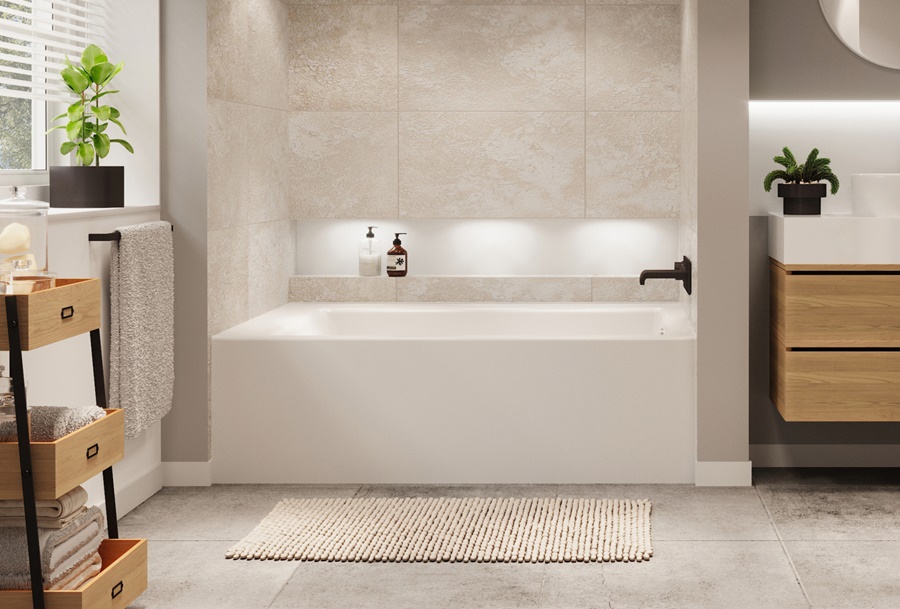When it comes to choosing a bathtub that combines space efficiency, comfort, and style, alcove bathtubs stand out as a top choice for homeowners and designers alike. These tubs are not just a practical solution for compact bathrooms they also provide a seamless, finished look that enhances the aesthetic appeal of any bathroom setting.
What Is an Alcove Bathtub?
An alcove bathtub is a tub installed in a recessed three-wall enclosure, with only one finished side, known as the apron or skirt. This configuration makes it ideal for maximizing space in smaller bathrooms, particularly in apartments, condos, and urban homes. The alcove design typically incorporates a shower combo, making it a popular and cost-effective option for families and households with limited space.
Key Features of Alcove Bathtubs
1. Three-Wall Installation
Alcove tubs are uniquely defined by their three-wall installation, where the tub is surrounded on three sides by walls. This design supports a clean, built-in look that integrates seamlessly with existing tiling and bathroom fixtures.
2. Skirted or Apron Front
Unlike freestanding or drop-in tubs, alcove bathtubs have a pre-finished front panel. This makes them easier and less costly to install, as there is no need for additional carpentry or custom finishing work.
3. Versatile Sizes
Alcove tubs come in various dimensions, but the standard size is typically around 60 inches long, 30 inches wide, and 14 to 16 inches deep. They are designed to fit standard bathroom layouts without extensive remodeling.
4. Durable Materials
Common materials for alcove bathtubs include:
Acrylic – Lightweight, affordable, and resistant to chipping.
Fiberglass – Budget-friendly and easy to install, though less durable over time.
Porcelain-Enameled Steel – Offers a sleek, glossy finish and improved longevity.
Cast Iron – Extremely durable and retains heat well, though it is significantly heavier and costlier.
Benefits of Installing an Alcove Bathtub
Space Efficiency
The recessed installation of alcove bathtubs makes them the go-to choice for small or medium-sized bathrooms. Their design allows for maximum use of the available floor space while maintaining full bathing functionality.
Shower Integration
Most alcove tubs are designed to accommodate showerheads, making them perfect for tub-shower combos. This dual-purpose functionality is especially beneficial in households with limited bathroom facilities.
Cost-Effective Option
Alcove bathtubs are often more affordable than freestanding or whirlpool tubs. The straightforward installation process reduces labor costs and the need for additional finish work.
Safety Features
The enclosed nature of alcove bathtubs makes them safer for children and elderly users. Handrails, slip-resistant surfaces, and lower step-in heights can easily be added to enhance safety.
Types of Alcove Bathtubs
Standard Alcove Tub
This is the most common variant, offering a simple design suitable for everyday use. Typically made from fiberglass or acrylic, standard alcove tubs are affordable and easy to maintain.
Soaking Alcove Tub
These are deeper than standard tubs, designed for users who enjoy long, relaxing baths. Soaking tubs can hold more water and often have sloped backs for added comfort.
Whirlpool or Jetted Alcove Tub
For a spa-like experience, jetted alcove tubs feature hydrotherapy jets that massage muscles and improve circulation. These models are ideal for relaxation and therapeutic use.
ADA-Compliant Alcove Tubs
These tubs meet Americans with Disabilities Act (ADA) standards. They often include grab bars, built-in seats, and lower thresholds to assist users with limited mobility.
Installation Considerations
Wall Preparation
Before installing an alcove tub, ensure the three walls surrounding the tub are framed properly and can support the tub’s weight. Proper water-proofing, especially behind tiled walls, is essential to avoid future leaks and water damage.
Plumbing Configuration
Alcove tubs are available in left-hand and right-hand drain configurations. It's crucial to match the drain location with your existing plumbing to avoid unnecessary renovation.
Support and Leveling
Always use a mortar base or leveling pads beneath the tub, especially for heavier models. Proper support ensures even weight distribution and prevents cracking or squeaking over time.
Maintenance and Cleaning Tips
Alcove bathtubs are relatively easy to maintain. Here are some key tips:
Regularly clean with mild detergent to prevent soap scum and mildew.
Avoid abrasive cleaners that can scratch acrylic or fiberglass surfaces.
Rinse thoroughly after each use to remove residues.
Inspect caulking and grout lines periodically to prevent water intrusion.
Comparing Alcove Bathtubs to Other Types
| Feature | Alcove Bathtub | Freestanding Tub | Drop-In Tub |
|---|---|---|---|
| Installation | Easy, cost-effective | Requires space & plumbing | Needs deck or surround |
| Space-saving | |||
| Shower compatible | Rarely | Sometimes | |
| Design flexibility | Limited to alcove | Highly versatile | Moderate |
| Cost | Affordable | Expensive | Moderate to High |
Is an Alcove Bathtub Right for You?
If you're looking for a bathtub that:
Fits into smaller bathrooms
Allows for combined bath and shower
Is budget-friendly
Is easy to maintain and clean
Then an alcove bathtub is a highly practical and stylish choice. Whether you’re remodeling or building new, its functional design and versatility make it one of the best investments for your bathroom.
Top Brands Offering Alcove Bathtubs
Some of the most trusted manufacturers for alcove bathtubs include:
Kohler
American Standard
Bootz Industries
Duravit
MAAX
These brands offer a wide variety of models, materials, and sizes to meet different needs and budgets.
Conclusion
The alcove bathtub is a smart, space-conscious solution that balances affordability, style, and functionality. Whether you're upgrading your home or optimizing a tight bathroom layout, this bathtub design offers unmatched utility without compromising on comfort.

